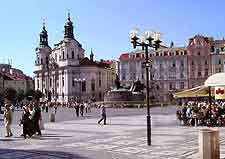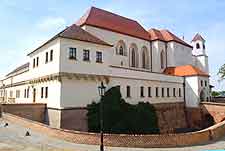Brno History Facts and Timeline
(Brno, South Moravia, Czech Republic)

With strong prehistoric origins, the city of Brno's history is a lengthy one, with much of its success being attributable to its location at the meeting point of both the Svitava River and the Svratka River.
Brno is known to be directly descended from a settlement named Staré Zámky, which is remembered for its extensive fortifications and strong connections with the former Slavis state of Great Moravia. Staré Zámky was already established during the latter part of the Stone Age and is thought to have grown for many centuries.
The Arrival of the 11th Century
The 11th century was a pivotal time for the history of Brno and the city witnessed many significant changes. Located on the Petrov Hill, a chapel was built, which was modified a number of times over the centuries and now appears in the form of the Cathedral of St. Peter and Paul.
The elevated and still extremely beautiful Spilberk Castle came into being in the 13th century, when it served as a grand royal fortress, and later as the seat of the governing Moravian noblemen. At this time in Brno history, the king bestowed various privileges to the town, including the title of 'royal city'. Towards the end of the 14th century's first quarter, Polish Queen Elisabeth Richeza was responsible for the creation of the Church of the Assumption of Virgin Mary, and this is where she was later buried, following her death in 1335.

Rising up the Moravian Ladder
During the 14th century, Brno played a key role for Moravia, regularly hosting the region's assembly meetings, along with the city of Olomouc. It was at these meetings where many important decisions were made in the worlds of politic, finance and law.
During the early part of the Thirty Years' War (1618 to 1648), the 1620 Battle of White Mountain resulted in the imprisonment of those involved with the anti-Habsburg movement, who were locked up at Spilberk Castle. The castle also helped to successfully protect Brno against various attacks from the Swedes at this time. Soon, Brno was amongst the most important of all the cities in Moravia, and it finally became the capital in the year of 1641.
Alterations to Spilberk Castle
As the 17th century progressed, the state of Brno continued to rise and the council was keen to make this city appear like a capital. Much building and reconstruction work was undertaken, including the eventual transformation of Spilberk Castle into a magnificent baroque-style citadel, and later as a military fortress where criminals were imprisoned once more. Just as the last quarter of the 18th century began, the city witnessed the creation of the Brno Bishopric.
Modern Times Just Around the Corner
The 19th century marked an exciting century in history for so many cities around Europe, and in Brno, it was the building of the steam railway in the late 1830s that had huge knock-on effects for both the city's growth and prosperity. Now with direct rail connections to
Vienna, the city enjoyed newfound trade links and quickly expanded its boundaries, demolishing the majority of its fortifications in the early 1860s. Soon after, in 1869, the city boasted the Czech Republic's earliest horse-car service, the origins of its modern trams. In 1899, the Brno University of Technology was established, which is currently called home by around 25,000 students.
The 20th Century History, Onwards
In the year of 1919, more than 20 different municipalities came under the control of the city and the municipality of Greater Brno was born. After WWI had ended, a large proportion of the city's population spoke German. At the hand of the Nazis, WWII resulted in the execution of the city's Jewish community, which numbered more than 10,000. When the war ended, those who spoke German were made to leave the city, with almost 30,000 of Brno's inhabitants forcibly ejected into neighbouring Austria.
From 1948, the Moravia region was subdivided when communism made an appearance in the Czech Republic. Brno now heads up the Regional Authority of the South Moravian Region (better known as simply the Brno region), becoming second only to
Prague.
Today, business visitors flock to the city, due to its relative proximity to southern Poland, as well as a number of capital cities, such as those of Bratislava (Slovakia), Prague (the Czech Republic) and Vienna (Austria). Looking for something quite different, tourists will be wowed by the sheer beauty of the architecture, whilst also being drawn by the motor racing, the zoological gardens and the plentiful museums. For history buffs in Brno, the Moravian Museum (Moravské Zemské Muzeum) on the Zelny Trh makes a good first port of call and is around two centuries old.
 With strong prehistoric origins, the city of Brno's history is a lengthy one, with much of its success being attributable to its location at the meeting point of both the Svitava River and the Svratka River.
With strong prehistoric origins, the city of Brno's history is a lengthy one, with much of its success being attributable to its location at the meeting point of both the Svitava River and the Svratka River.